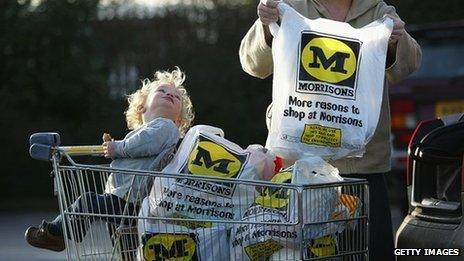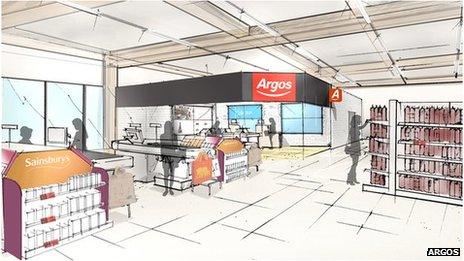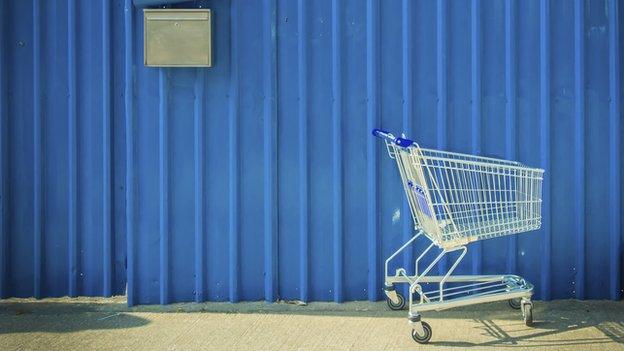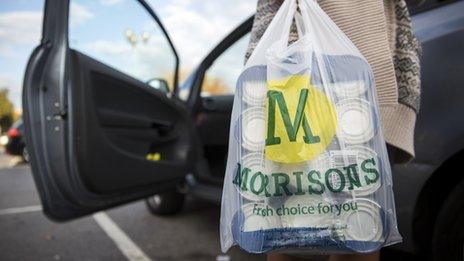Supermarkets: Everything 'up for grabs'
- Published

For decades supermarkets just got bigger and bigger.
Selling bread and beans was all very well, but the real growth was to be found in tempting shoppers with other products.
Swimsuits, barbecue kit, microwaves, Halloween costumes - the merchandise became more and more exotic.
Going to the supermarket became an endurance event as trolleys became bigger, to hold flat screen televisions and computer printers.
It was not uncommon to see shoppers trying to wrestle two trolleys through the checkout.
It all seems slightly comical now, unless of course you are a supermarket boss.
'Profound uncertainty'
Shopping habits have changed, leaving supermarket chiefs wondering what do to with their cavernous stores.
"I've never seen such profound uncertainty; everything is up for grabs," says veteran retail industry expert Richard Hyman.
For shoppers it means that supermarkets are likely to look very different in years to come.
The biggest stores could become more like department stores and also house other services like gyms, nail bars and parcel collection points.
But what's prompting this "profound uncertainty" and urgent need for change?
'Super profits'
From around 2005 supermarkets were chasing market share.
So the big supermarket chains built more stores and in the case of Tesco, and to a lesser extent Sainsbury's, they built very big stores.
There was plenty of money for investment back then as supermarkets were making "super profits" says James Watson, head of retail investment at Colliers International a leading commercial property consultants.
But that strategy began to fall apart when the recession hit and, in a remarkably short period of time, shoppers changed their spending habits.
The slow recovery in wages after the financial crisis made shoppers more cost conscious and some switched to discounters like Aldi and Lidl.
Other customers started to shop online and top-up their shopping from the growing number of convenience stores.

Shoppers have been moving away from the big 'trolley shop'
Size matters
Those trends have proved a challenge for the supermarkets - particularly those that invested in giant stores.
"No food supermarket should ever be bigger that 45,000 square feet," says Bruno Monteyne, senior analyst of food retail at investment firm Bernstein.
That figure may not mean a lot to you, but it's the size of small football pitch and about the size of the average supermarket.
Mr Monteyne estimates that 20% of Tesco's store space is "heavily under utilised". For Sainsbury's he says the figure is 10%.
He thinks Asda is somewhere between the two, but as it's owned by US giant Walmart, it is harder to make an estimate.
Morrisons has a smaller proportion of the huge stores, so it is less troubled by under used space, but it has been hurt by competition from discounters.

Sainsbury's is experimenting with Argos stores in its supermarkets
Dead space
Supermarkets have begun to acknowledge that they have a space problem.
In some cases the value of their property portfolios has been written down - an accounting measure to reflect the reduced value of their stores.
In March Morrisons took a £1.3bn charge corresponding to the falling value of its properties.
And the fall in value of Tesco's property portfolio accounts for around £4.7bn of its record £6.4bn loss.
The retailers have also been coming up with new ways to use space that is currently unprofitable.
Back in November Sainsbury's said that only 6% of its total store space was under utilised. It said that half of that space would be used to sell its clothing lines and other "general merchandise" and they were "looking at opportunities for the remaining 3%".
One such opportunity was detailed in January when Argos announced plans to open ten pilot stores in Sainsbury's.
Analysts speculate that Tesco might do a deal with Sports Direct under which the sports retailer would open concessions within Tesco supermarkets.
Parts of the biggest stores could even be converted into mini-malls, with space for other smaller retail outlets like dry-cleaners, nail bars or gyms.
Another innovation might be to open click-and-collect desks, where customers could pick up parcels ordered from other online retailers.
"Supermarkets will become the post office of the future, as sort of a hub for local communities," speculates Mr Monteyne.

Nail bars may be among the retailers that take space in big supermarkets
Looming price war
Richard Hyman is not optimistic about that strategy.
"Generally these joint ventures, they don't work," he says.
"There have been loads of these and generally they usually come out of weakness and not out of strength."
He is also doubtful about the merits of supermarkets expanding their non-food businesses.
"The grocery business is just not very good at selling non-foods," he says.
For Mr Hyman the big supermarkets have got to get better at the core things they do instead.
And, in his opinion, that is likely to result in a further round of price cuts.
Once Tesco has "cleared the decks" he thinks the company needs to be "much, much, much more aggressive in price" particularly compared to the other big three retailers.
"I think the price war is down the road - it's going to happen," he says.
Good news if you're still in the habit of packing your trolley to the brim.
- Published19 January 2015
- Published5 October 2014

- Published28 January 2015

- Published7 January 2015

- Published12 March 2015
